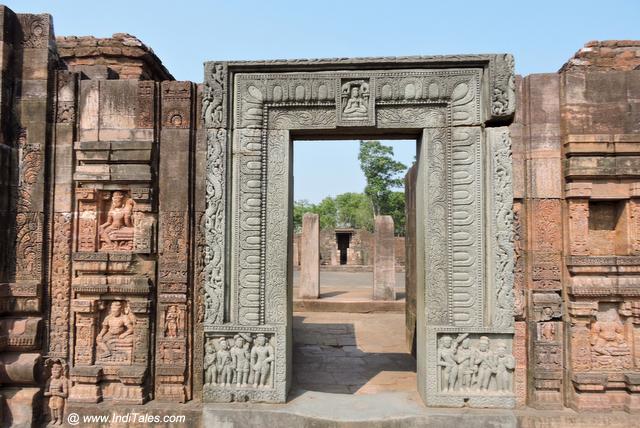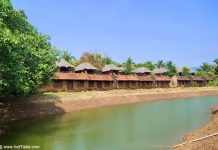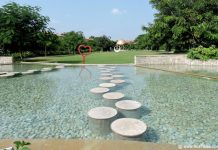India is an ancient land. This means it has regions that have been continuously inhabited since proto-historic times to our present times. While we do know of ancient, historic, and sacred cities like Ayodhya or Kashi, there are many other similar sites across the country. One such example is the ancient city of Jajpur in Odisha.
Jajpur today is a district in Odisha. It is known both as being the seat of Adi Shakti Biraja Mata Shaktipeeth and for being a steel hub, endowed with rich mineral deposits in its soil. As you read through its history, you see this town taking many names and each name carries the essence of the time it was in vogue.
Come with me to walk through the brief history of Jajpur through its names.
Brief History of Jajpur
Baitarani River is the oldest living entity at Jajpur. It is the mythical Vaitarni that we crossover to enter the higher realms. At Jajpur, she flows quietly nurturing this ancient land. On its banks stand many old and sacred temples. Many periodic fairs are held along its banks.

It is integral to the Tarpana rituals performed here and hence is also called Baitarani Tirtha.
In modern times, it serves as a long boundary of the district of Jajpur.
Brahmani is another important river that flows through and nurtures the region.
Pauranic Times
Yajna Kshetra, Sati Pitha, Biraja Kshetra are some of the names that take us back to the story of the famous Yajna that was performed here.

Brahma performed a Yagna here at Brahma Kund and from the Yagna Vedi or alter appeared the goddess Biraja. Brahma himself installed the Murti here. Since the Devi appeared from Yajna, Yajnapura is the oldest name associated with the city.
It is called Nabhi Gaya for it is believed to be the place where the navel of the Gayasur is located, making it at par with Gaya in Bihar. Both places are known for the Pinda Dana or the Tarpana.

It is also home to a temple dedicated to Shweta Varaha – which is the name of the present Kalpa as per the Hindu Calendar. Shakti is also worshipped here in form of Saptamatrika whose temple stands right next to the Baitarani river.
Mahabharata
Vana Parva of Mahabharata tells us that Pandavas visited this region during their pilgrimage across the country. Yudhishthira, the eldest Pandav performed a Dharma Yajna here.
Duryodhan’s wife Bhanumati was a princess of Kalinga whose capital Rajpur is identified with Jajpur. Her father Shatruyudh fought on the side of the Kauravas in Mahabharat War.
Gada Kshetra
Odisha has four sacred regions named after the four weapons or Ayudhas of Vishnu. Puri is called Shakha Kshetra, Konark is called Padma Kshetra, Bhubaneshwar is called Chakra Kshetra and Biraja’s Kshetra i.e. Jajpur is known as the Gada Kshetra.
Pre-Historic Times
Records of pre-historic times appear on their own every now and then. Jajpur region has many archaeological sites belonging to different eras of Pre-historic times. For example, there are six open-air paleolithic sites at Darpangarh, Sunamukhi Tanger, Ranibandi, Dhanmandal and Mahagiri Tanger.

Thousands of artifacts such as blades, flakes, scrappers, chisel etc have been discovered from these sites.
An Iron age site has been discovered at Chandikhole. Apart from various iron smelting equipment, different types of ceramic pots have also been discovered here.
Historic Times
Many times in the history of Jajpur, it was the capital of the region. Exact boundaries and the names of the region changed from time to time like Kalinga, Utkala, Odra, Toshali, Odisha, etc but the city continued to be the capital. Kingdoms exchanged hands between successive dynasties but Jajpur maintained its status as a capital city for a long time.
It is said that after Mahabharata, 32 generations of kings ruled Kalinga after which it came under Nandas of Magadh around 4th BCE. It again became a powerful independent kingdom at the dawn of the Mauryan empire.
Mauryan king Ashoka’s Kalinga war is famous for many reasons. At Jajpur, it meant the advent of Buddhism which would eventually flourish here for a long time.
After Mauryans, the region came Chedi kings with their capital at Shishupalgarh near present-day Bhubaneshwar. Jajpur was no longer the capital city of the region but was a part of North Kalinga under Kharvelas during the 1st and 2nd BCE. It passed on to Kushanas during the early centuries of the first millennium and who ruled the region through their vassals, in all 13 Murunda kings.
We really do not know if the Gupta dynasty ruled the region, but their influence on the culture is visible. It is believed that the Murti of Biraja Mata dates back to their times. Their gold coins have also been recovered from the region. They also funded the Buddhist monasteries at Ratnagiri and Lalitgiri.
In the 6th CE, Prithvi Vigraha ruled the region. In the early 7th CE, it came under Harshavardhan when the region was called Odra-Visaya which is none other than Viraja Mandala or Jajpur.

7th CE traveler Huan Tsang visited Jajpur and mentions it as Jajapur in his travelogue. He mentions people of the region as tall and dark-complexioned, with great love for learning. He talks about hundred-odd monasteries and more than fifty Hindu temples in the region.
In the mid-8th CE, Bhaumakars emerged as a powerful dynasty from Jajpur to rule most of present-day Odisha and beyond. What is very interesting about this dynasty is that of the 18 rulers who ruled for more than 200 years, 6 of them were women rulers. Of these Tribhuvana Mahadevi was the first ruler. I wonder if any other dynasty has nurtured so many powerful female rulers.
Jajpur during this time was known as Guhadeva Pataka or Guheswara Pataka, and the time is referred to as Bhauma Era in many copper plate inscriptions. Culture flourished in the form of art, architecture, literature, language, and social design. This is called the golden period of Jajpur.
It is believed that Odia language took shape during this time.
Jajati Keshari and Golden Era of Jajpur
In the mid-10th CE, Bhaumakars fell to Jajati-I of South Kosala. After a period of turmoil, Chandihara, who called himself Jajati-II of the Somvamshi dynasty rose to power. He was later called Jajati Keshari, and would be remembered for building many temples like Viraja temple, Varaha temple and Subhastambha.
He renamed the capital Abhinava Jajatinagara. His son Udyota Keshari would later build the Lingaraja temple at Bhubaneshwar.
King Jajati wanted to perform Dashashwamedha Yagna here to mark his empire. For this, he brought 10,000 Brahmins from Kannauj in North India. He settled them across his kingdom by giving them land grants called Sansanas. Even today many purohits in the region trace their origin to this migration.
Dashashwamedha Ghat on the banks of the Baitarani river is a reminder of this major yajna performed by Jajati Keshari.
In the early 12th CE, Jajpur came under the Eastern Ganga dynasty but Jajpur continued to be the capital for almost a century after which it moved to Cuttak. Jajpur transformed from being a cultural and political capital to being an army cantonment to deal with the Afghan invaders.
In the 16th CE it had to suffer destruction at the hands of Kala Pahad, who destroyed almost every temple in the region. Temples were demolished, Murtis were mutilated and thrown into river Baitarani.

During the subsequent years, Raja Man Singh of Rajasthan and Bhosle Marathas of Nagpur did rebuild some of the temples like Jagannath temple, Saptamatrika temple, Siddheshwar temple, etc. From the early 19th CE till Indian independence, it was of course under British Governance.
People of Jajpur played their role in the freedom movement, responding to the calls given by leaders like Gandhi ji.
Jajpur as a cultural and political Capital
Coins recovered from various excavations indicate that Jajpur was part of trade routes during different times.
All three ancient Indic religions – Hinduism, Buddhism and Jainism flourished on Jajpur, sometimes even simultaneously. This is evident in the presence of many large Buddhist monasteries in the district like Udayagiri, Ratnagiri, Lalitgiri, and Langudi Pahada or Pushpagiri.
Jajpur Today
Jajpur district was carved out of Cuttak district in 1993. Today it is one of the most densely populated districts of Odisha.
The mining industry here gives us minerals like chromite, iron ore, and nickel. In fact, Jajpur is a leader in Chromite Ore which is used in many industrial productions like steel.
Kalinga Nagar Integrated Industrial Complex is a steel hub with many big and small steel plants. In a way, it is living its ancient legacy of iron ore smelting, even today.
These modern industries co-exist with traditional ones like tussar silk weaving, wood carving, and stone carving. We will talk about these in subsequent posts. Agriculture and mining are the biggest economic drivers of the district. In the future, it would be home to prominent waterways in the country.
Overall, Jajpur is a perfect combination of an ancient land with layers of history and heritage, blessed with natural resources that is home to both heavy as well as cottage industries. There is a lot for the curious traveler to explore in this hidden gem of Odisha.













